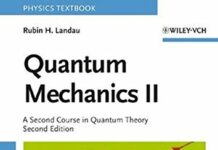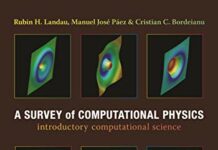
Ebook Info
- Published: 2007
- Number of pages: 616 pages
- Format: PDF
- File Size: 11.36 MB
- Authors: Rubin H. Landau
Description
This second edition increases the universality of the previous edition by providing all its codes in the Java language, whose compiler and development kit are available for free for essentially all operating systems. In addition, the accompanying CD provides many of the same codes in Fortran 95, Fortran 77, and C, for even more universal application, as well as MPI codes for parallel applications. The book also includes new materials on trial-and-error search techniques, IEEE floating point arithmetic, probability and statistics, optimization and tuning in multiple languages, parallel computing with MPI, JAMA the Java matrix library, the solution of simultaneous nonlinear equations, cubic splines, ODE eigenvalue problems, and Java plotting programs.From the reviews of the first edition:”Landau and Paez’s book would be an excellent choice for a course on computational physics which emphasizes computational methods and programming.” – American Journal of Physics
User’s Reviews
Editorial Reviews: Review “Landau and Paez’s book would be an excellent choice for a course on computational physics which emphasizes computational methods and programming.”(American Journal of Physics) From the Back Cover This second edition increases the universality of the previous edition by providing all its codes in the Java language, whose compiler and development kit are available for free for essentially all operating systems. In addition, the accompanying CD provides many of the same codes in Fortran 95, Fortran 77, and C, for even more universal application, as well as MPI codes for parallel applications. The book also includes new materials on trial-and-error search techniques, IEEE floating point arithmetic, probability and statistics, optimization and tuning in multiple languages, parallel computing with MPI, JAMA the Java matrix library, the solution of simultaneous nonlinear equations, cubic splines, ODE eigenvalue problems, and Java plotting programs.From the reviews of the first edition:”Landau and Paez’s book would be an excellent choice for a course on computational physics which emphasizes computational methods and programming.” – American Journal of Physics About the Author Rubin H. Landau, PhD, is a professor in the Department of Physics at Oregon State University in Corvallis. He teaches courses in computational physics, helps direct the Northwest Alliance for Computational Science and Engineering, and has been using computers in theoretical physics research for the past 30 years. The author of more than 70 refereed publications, he has also authored the books Quantum Mechanics II, A Scientist’s and Engineer’s Guide to Workstations and Supercomputers, and the first edition of Computational Physics, all of them available from Wiley.Manuel J. Páez, PhD, is a professor in the Department of Physics at the University of Antioquia in MedellÃn, Colombia. He teaches courses in computational physics, programming, and nuclear physics. He and Professor Landau have conducted pioneering computational investigations in the interactions of mesons and nucleons with nuclei.Cristian C. Bordeianu received his physics degree from Bucharest University, Romania, and his M.Sc. degree in Computer Science from “A.I.Cuza” University in Jassy, Romania. He is currently completing work towards a Ph.D. degree in Nuclear Physics at Bucharest University. He has over ten years of experience in developing Computational Physics educational software for high schools and University curricula. His current research interests include chaotic dynamics in nuclear multifragmentation and plasma of quarks and gluons. Read more
Reviews from Amazon users which were colected at the time this book was published on the website:
⭐I took an upper division Computational Physics course at the same time as an upper division Numerical Analysis course and recommend the pairing of those two subjects for learning this material if you can. I liked the applied nature of this book and the background information provided with the exercises so you had an idea what the underlying mathematics being used in the problem was. It didn’t have much on the underlying computer science basics.
⭐Still useful
⭐Thank you.
⭐I have been using this text for a graduate course in computational physics. In contrast to the more pedestrian monographs on the subject, this one is written in an accessible, lively style with many examples, code fragments, and exercise problems accompanying every chapter. Mathematical derivations are kept to a bare minimum, so the book could be used for undergraduate courses, provided the students know their physics. The book contains an unusually large number of figures, all of which are of high quality.The book is not all inclusive. Several important subjects, such as sparse matrices, spectral methods, and particle-in-cell, are missing. I noticed a fair number of typos that will hopefully be corrected by the next edition. Overall, however, this is a good modern introduction to numerical methods that I can recommend as a textbook for an upper level undergraduate of an introductory graduate course. The instructor might want to supplement the material with own notes on missing derivations and a few subjects not covered in the book.
⭐The number of stars I gave the book is basically irrelevant.I’m writing the review to point out that the book should be called: “computations for *advanced* physics”.Most of the topics covered in the book are for second year physics, or advanced topics. That’s neither good nor bad, it just depends what you’re looking for. If you want to find ways to apply computer programs in a first-years course — this ain’t it. There are probably only a few cases in which the topics are close enough to first-year physics to be relevant (multiple waves on a string; contrasting an idealized model of a pendulum with a “real-one”).Having said that, I give the book some pluses for covering a wide range of physics and mathematical topics, and a bit of a minus for writing that can be fairly opaque.
⭐Not 5 stars only because the the book is an older version of the one in the picture. It has the same content, however.
⭐It’s very useful.
⭐
Keywords
Free Download Computational Physics: Problem Solving with Computers 2nd Edition in PDF format
Computational Physics: Problem Solving with Computers 2nd Edition PDF Free Download
Download Computational Physics: Problem Solving with Computers 2nd Edition 2007 PDF Free
Computational Physics: Problem Solving with Computers 2nd Edition 2007 PDF Free Download
Download Computational Physics: Problem Solving with Computers 2nd Edition PDF
Free Download Ebook Computational Physics: Problem Solving with Computers 2nd Edition

